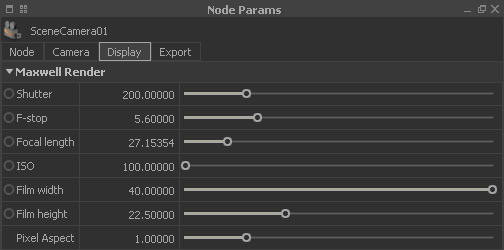Cameras - Maxwell Render
If you want to create renders from your simulation directly within RealFlow using → Maxwell Render then you can use the physical camera model. Here are the parameters:
Shutter
This parameter determines for how long the camera's "sensor" will be exposed to light and it is also responsible for motion blur effects. Smaller values create brighter images and longer motion blur streaks. By default, is value is taken from the → camera's own “Shutter” parameter, but it can be overwritten here. The unit is, as in real world photography, 1 / shutter value seconds.
F-stop
Controls the size of the aperture of the camera "lens". This parameter affects both exposure and depth of field.
Focal length
Here you can adjust the the physical camera "lens's" field of view (FOV) and depth of field (DOF). Both, "FOV" and "Focal length" are directly connected.
- A small focal length lens (15-24mm) is said to be a wide-angle lens; its DOF is wide too.
- A large focal length lens (80-200mm) is said to be a telephoto lens.
- Smaller settings lead to distortions.
ISO
This is the camera's light sensitivity. The lower the ISO, the more light is required to get a well-lit image. In contrast to real films/sensors, RealFlow's ISO does not add noise to the image.
Film width
The physical width of the digital sensor or film of the camera.
Film height
The physical height of the digital sensor or film of the camera.
Pixel Aspect
Width-height proportion of the pixels. Useful when the rendered image will be displayed on devices which have non-square pixels, e.g. TV sets.
